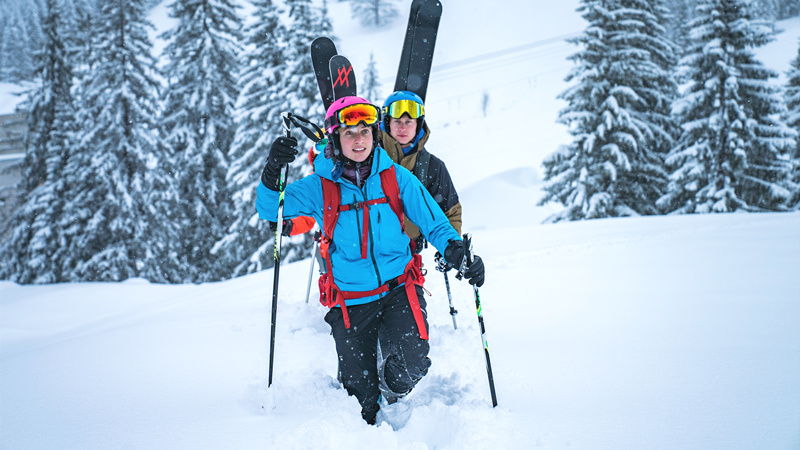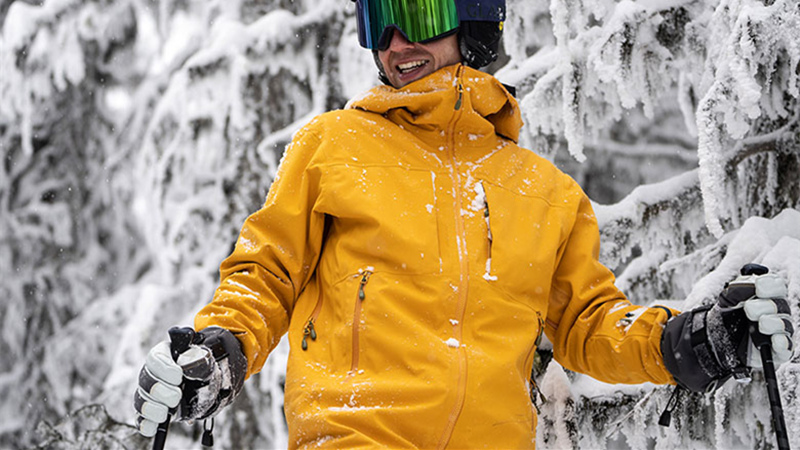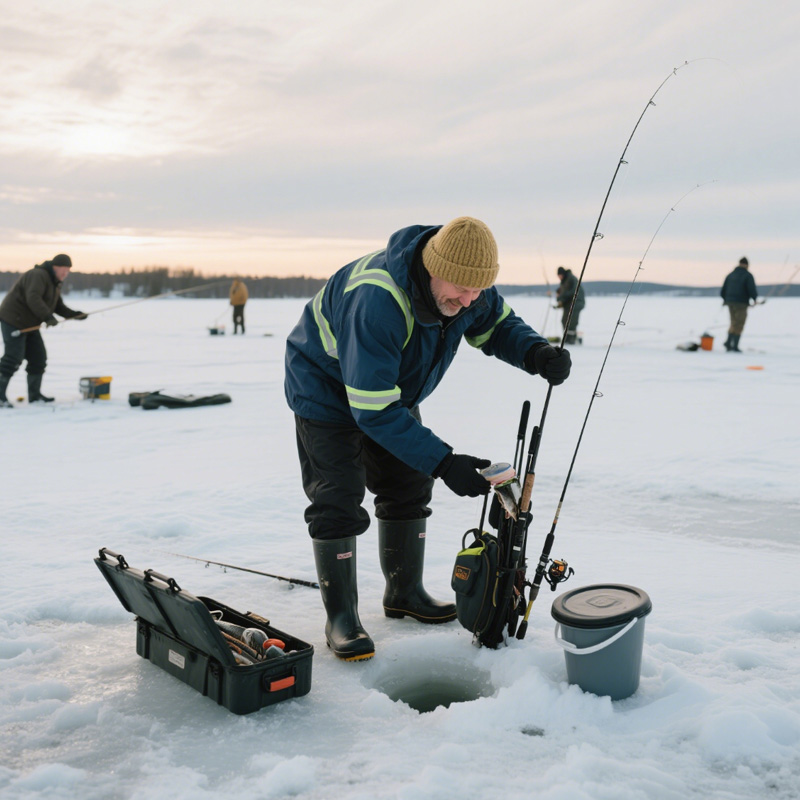Insulated ski jackets and shell ski jackets are two types of winter sports apparel designed to provide protection against cold weather and other elements commonly encountered while skiing. As the winter season approaches, skiers and snowboarders alike are gearing up for the slopes. When it comes to choosing the right outerwear, one of the key decisions is whether to opt for an insulated ski jacket or a shell ski jacket. Both offer distinct advantages, and the choice ultimately depends on personal preferences and the specific demands of your winter activities.
In this comprehensive article, we’ll explore the similarities and differences between insulated and shell ski jackets to help you make an informed decision.

1. What Are Similarities Between Insulated Ski Jacket Vs Shell Ski Jacket?
Both custom insulated ski jackets and shell ski jackets are designed to keep you warm, dry, and protected while skiing, but they achieve this in different ways. Here are some similarities between the two types of ski jackets:
1.1 Waterproofing and Breathability
Both insulated and shell ski jackets prioritize waterproofing and breathability to protect against snow and rain while allowing moisture from sweat to escape. They typically feature high waterproof and breathability ratings to ensure comfort and dryness. BOWINS Garment has a fabric expert who can help you choose your custom fabric.
1.2 Weather Protection
Whether insulated or shell, ski jackets are designed to provide protection against harsh winter conditions, including wind, snow, and cold temperatures.
1.3 Features for Skiing
Both types of ski jackets often include features specifically tailored to skiing, such as RECCO reflectors for avalanche safety, ski pass pockets, ventilation systems, and hoods compatible with ski helmets.
1.4 Durability
Insulated and shell ski jackets are constructed with durable materials to withstand the abrasion that comes with skiing, ensuring longevity and performance.
1.5 Adjustable Features
Both styles of ski jackets usually have adjustable cuffs, hems, and hoods to customize the fit and prevent cold air from entering.
1.6 Importance of Layering
Both require proper layering underneath to achieve optimal warmth and moisture management. The base layers and mid-layers you choose can significantly impact your comfort and performance on the slopes.
1.7 Style and Aesthetics
While there may be variations in design based on the type of jacket, both insulated and shell ski jackets come in a range of styles and colors to suit personal preferences and fashion sense. BOWINS Garment’s design department can achieve your idea as a 3D model, and you can see the final effect without making a sample.
1.8 Hood Options
Both types of jackets often offer detachable hoods, providing flexibility based on weather conditions and personal preference.
1.9 Seasonal Versatility
Both can be suitable for different times of the year, with some offering greater warmth for deep winter conditions and others being lighter for late or early season skiing.
While these similarities highlight the common goals of keeping skiers protected and comfortable, it’s important to understand the specific differences in insulation and functionality to make the best choice for your needs. Insulated ski jackets offer built-in insulation for warmth, while shell ski jackets are typically lighter and more versatile, often requiring additional layers underneath for warmth. When you customize your insulated ski jacket or shell ski jacket, the BOWINS Garment’s design team will help you take all factors into account.
2. What Is The Difference Between Insulated Ski Jacket Vs Shell Ski Jacket?
The primary difference between an insulated ski jacket and a shell ski jacket lies in their construction, particularly in regards to insulation. Here’s a detailed comparison:
2.1 Insulation
Insulated ski jackets have built-in insulation, which can be synthetic (like polyester fibers) or natural (like down feathers). This insulation provides warmth without the need for additional layers in many cases. Shell ski jackets lack built-in insulation and are designed to be worn over layers, such as fleece or wool mid-layers, to provide warmth.
2.2 Weight and Bulk
Insulated jackets are generally heavier and bulkier than shell jackets due to the added insulation layer. Shell jackets are typically lighter and more compact than insulated jackets, making them easier to carry and layer as needed.
2.3 Warmth
These jackets are designed to keep you warm in colder temperatures and are less breathable than shell jackets, making them suitable for less intense activities where overheating is less of a concern. Shell jackets often prioritize high breathability and waterproofing ratings, making them suitable for a wide range of conditions and more intense activities where sweat management is crucial.
2.4 Durability
Insulated jackets can be just as durable as shell jackets, but the insulation layer may make them harder to clean and dry if they get wet. Shell jackets are constructed to be highly durable and easily washable, focusing on protecting against external elements like wind and snow.
2.5 Flexibility
With their fixed insulation, insulated ski jacket offers less flexibility in adjusting to different weather conditions unless paired with different layers underneath. The lack of built-in insulation for shell ski jacket allows for greater flexibility in adapting to changing weather conditions by adjusting the layers underneath.
2.6 Ideal Use
Insulated ski jackets are ideal for skiers who prefer a warm, all-in-one solution and plan to ski in consistently cold temperatures. Shell ski jackets are ideal for skiers who want maximum versatility and the ability to layer according to the day’s weather and activity level.
2.7 Style
They often have a more substantial, puffy appearance due to the insulation layer. Shell jackets often have a sleeker, more streamlined look compared to the puffier appearance of insulated jackets.
2.8 Price
Insulated jackets can vary in price based on the type of insulation used, with some premium down-insulated jackets being more expensive. Shell jackets also vary in price, with premium models featuring high-tech fabrics and advanced waterproof-breathable technologies commanding higher prices.
In summary, the key difference is that insulated ski jackets have built-in thermal insulation to provide warmth, while shell jackets rely on a protective outer layer and require additional layering underneath to achieve the desired level of warmth. The choice between the two ultimately depends on your specific needs, activity level, climate, and personal preferences.
Understanding these differences can help you choose the right type of ski jacket for your needs, whether you’re looking for warmth and insulation for a day on the slopes or a versatile, weather-resistant shell for a variety of outdoor activities.
If you can’t decide on a ski jacket and ask for help, consult the BOWINS Garment’s custom team for more details.

3. What Factors Should Consider When Choosing Right Insulated Ski Jacket Vs Shell Ski Jacket?
Choosing between an insulated ski jacket and a shell ski jacket depends on your personal preferences, the weather conditions you’ll be skiing in, and your level of activity. Here are some factors to consider:
3.1 Weather Conditions
If you’ll be skiing in cold, wet, or snowy conditions, an insulated ski jacket can provide extra warmth and protection. On the other hand, if you’ll be skiing in milder weather or want more breathability, a shell ski jacket may be a better choice.
3.2 Level of Activity
If you plan on being very active while skiing, a shell ski jacket may be more comfortable as it allows for more airflow and breathability. However, if you prefer a warmer jacket or plan on taking breaks, an insulated ski jacket may be a better option. BOWINS Garment’s pattern technicians can fully consider the ergonomics of insulation ski jacket and shell ski jacket for you and help you develop the perfect ski clothes.
3.3 Personal Preferences
Some people prefer the feel of an insulated ski jacket, while others prefer the flexibility of a shell ski jacket. Consider what feels most comfortable and practical for you.
3.4 Insulation Level
Evaluate the type and amount of insulation. Insulated jackets provide additional warmth, which is crucial for very cold days or high-altitude skiing.
3.5 Breathability
Consider how breathable each jacket is. Shell jackets are generally more breathable, which can be important for maintaining comfort during high-exertion activities.
3.6 Ventilation
Look for jackets with good ventilation systems, such as pit zips, especially if you tend to overheat easily.
3.7 Pockets and Storage
Ensure there are enough pockets for your needs, including secure storage for essentials like a mobile phone, ski pass, and goggles.
3.8 Safety Features
Some jackets may have reflective details (such as RECCO reflector) or other safety features that can be beneficial in low-light conditions.
3.9 Layering Options
If you plan on layering your clothing, a shell ski jacket may be a better option as it allows for more flexibility in adding or removing layers. An insulated ski jacket may limit your layering options.
3.10 Durability
Both types of ski jackets can be durable, but some insulated ski jackets may have more insulation that can wear down over time. Consider the quality of the materials used in the jacket before making a decision.
3.11 Brand Reputation
Research brands known for quality and durability in the specific type of jacket you are considering.
In the end, choosing between an insulated ski jacket and a shell ski jacket depends on finding the right combination of design, fit, and features that match your specific skiing conditions, activity level, and personal preferences. Taking the time to carefully consider these key factors will help ensure you make the best investment for your needs.
4. Conclusion
The choice between an insulated ski jacket and a shell ski jacket ultimately comes down to balancing your specific needs, activity levels, and personal preferences. Insulated jackets provide built-in warmth for colder conditions, while shell jackets offer more versatility and breathability. Consider factors like climate, layering needs, packability, and budget to determine which style best suits your skiing adventures. Whichever you choose, focus on quality, durability, and features that will keep you comfortable and protected on the slopes. With the right ski jacket, you’ll be able to enjoy the winter wonderland to the fullest.
Hopefully this blog post by the BOWINS Garment team will inspire you to choose the right insulation ski jacket or shell ski jacket and help you choose the best jacket for your adventure. The BOWINS Garment team’s 17 years of experience in producing ski clothes, combined with their custom service for major ski clothes brands, is what led to this blog post. If you happen to see this article, you are looking for a reliable outdoor clothes factory, then BOWINS Garment is absolutely your best partner, We have a factory of 600 people to meet your production needs, and a sample development team of 6 designers, 12 pattern makers and 20 sample makers can help you save a lot of time and cost in the early stage.
If you have any questions, please feel free to contact us!




